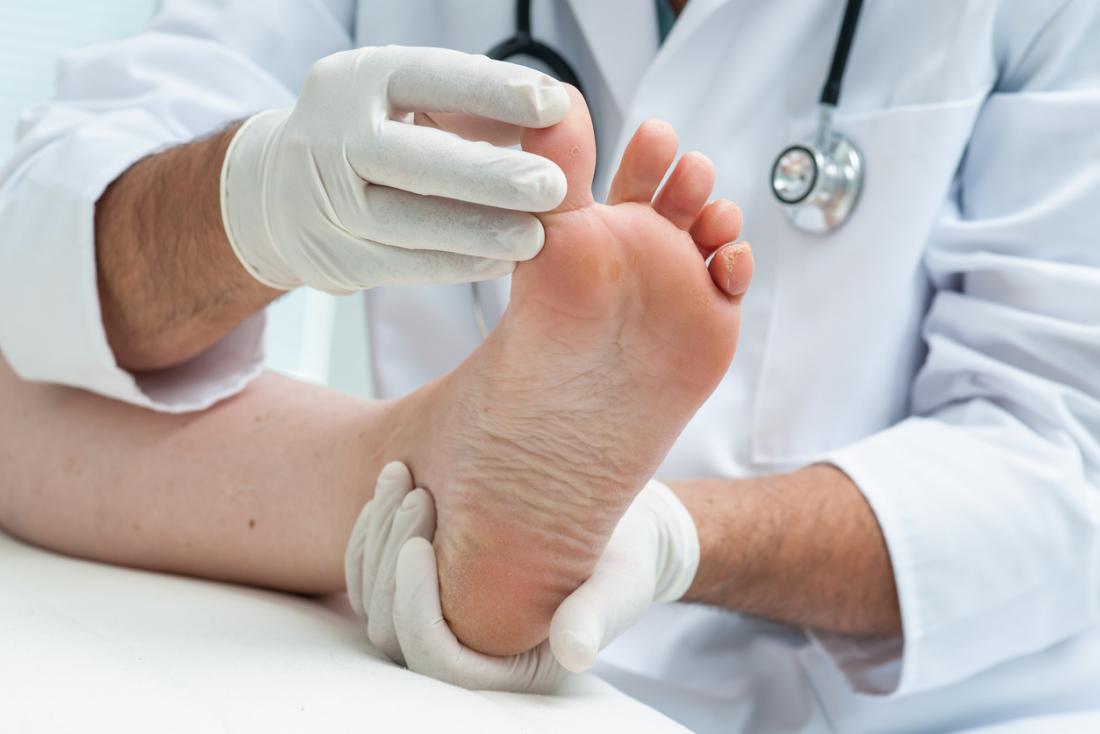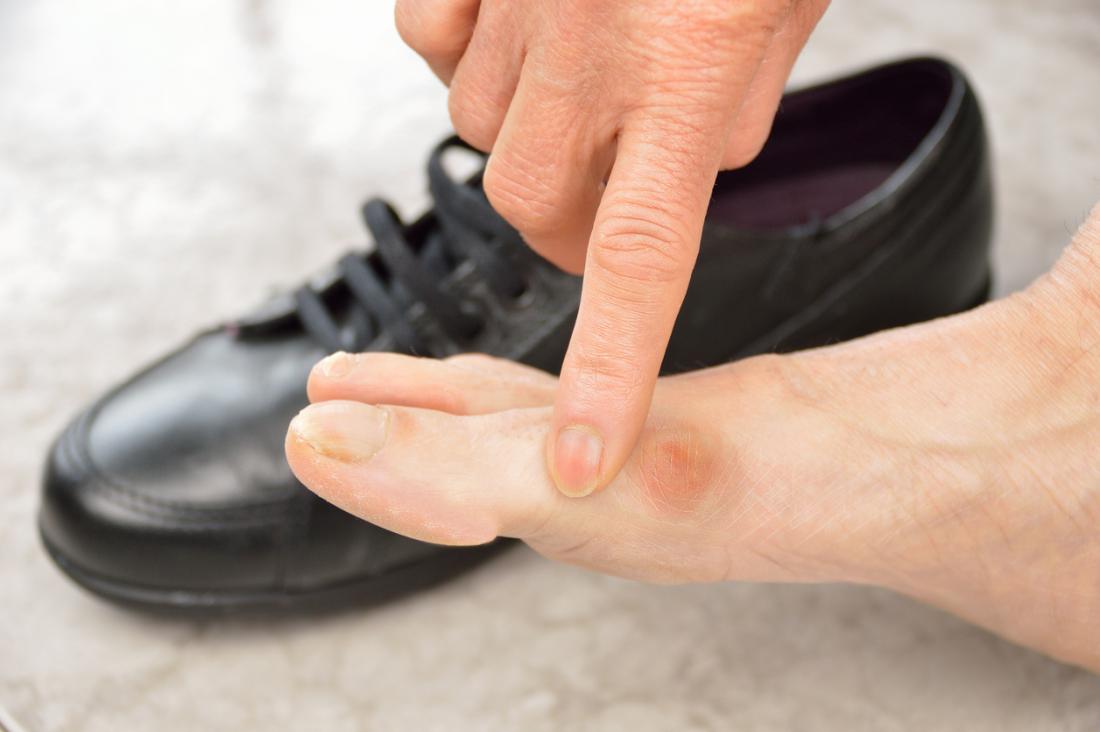From injuries to inflammation, various different types of problems and conditions can affect the feet. These include athlete’s foot, bunions, diabetic neuropathy, ingrown toenails, and more.
The feet are made of up 26 bones each, making them one of the most intricate areas of the body. Nevertheless, according to the College of Podiatry, a person will walk an estimated 150,000 miles in their lifetime, roughly the equivalent of walking around the world six times.
Improper footwear, diabetes, and aging are some of the chief contributors to foot problems. This article will highlight some of the most common foot concerns, their causes, and when to seek treatment.

Athlete’s foot is most commonly caused by walking in damp areas. It can be highly contagious.
Athlete’s foot is a fungal infection of the skin, usually found between the toes. However, the infection can spread and cause significant discomfort, itching, and even pain.
Causes
An individual is most commonly exposed to the fungus that causes athlete’s foot in a gym, shower, or pool where people walk around barefoot. Fungus tends to thrive in warm, damp areas.
Wearing shoes that are warm and damp can cause the fungus to grow and spread. The condition is highly contagious, and it can spread to other areas of the skin, including the hands, groin, and scalp.
Symptoms
Athlete’s foot causes itching, cracking, blistering, and peeling of the feet. The condition usually starts between the fourth and fifth toes, then spreads. A person can also develop cracks in the heels or skin of the toes.
Treatment
A person should keep their feet clean and dry, and dry them with a separate towel. Antifungal treatments are available in most drugstores as sprays, powders, or lotions to apply to the feet.
If the fungus is spreading or worsening after treatment, a person should see their doctor who can prescribe oral antifungal medicines for the condition.

Particularly tight or narrow footwear may cause bunions.
Bunions are abnormalities of the feet that cause a bump to develop on the large toe joint. This can cause the big toe to turn slightly inward. Doctors call bunions “hallux valgus.”
Women are more likely to have bunions due to increased pressures from narrow footwear.
Causes
Wearing tight or narrow shoes can cause bunions to develop. Tight shoes put pressure on the metatarsophalangeal joint (MTP), which is where the bone of the foot meets the bone of the big toe.
Having a family history of bunions is also a risk factor. Additionally, some conditions, including rheumatoid arthritis or polio, increase the likelihood of developing a bunion.
Symptoms
An individual with a bunion may have one or more of the following symptoms:
- visible bump on the side of the foot
- tenderness on or around the big toe
- callus or corn on the bone below the big toe
- difficulty moving the big toe
- pain in the big toe when walking
Treatment
Conservative treatment measures will usually improve the symptoms of a bunion. A person should wear properly fitting shoes without high heels. They can also buy a bunion pad at a shoe store or drugstore that protects the bunion from extra pressure.
Applying ice for 10-minute increments with a cloth-covered ice pack can also reduce inflammation.
A doctor who specializes in foot care known as a podiatrist can prescribe custom-made shoe inserts or a splint that can straighten the big toe. If a person’s bunion does not subside and causes continued pain, they may choose to have surgery to correct it.
People with diabetes are more prone to fluctuations in blood sugar. Diabetic neuropathy is not one condition, but a group of conditions that cause damage to the feet due to diabetes.
Causes
Over time, high blood sugar levels can damage the nerves, especially those in the feet. Other factors can make this nerve damage worse, such as a history of smoking, alcoholism, or history of diabetic neuropathy in the family.
Symptoms
Symptoms of diabetic neuropathy include numbness, tingling, and pain in the feet. This can contribute to a greater risk of a person experiencing cuts or injuries to the feet due to lack of feeling.
Treatment
Maintaining good health and blood sugar control can help a person treat their diabetic neuropathy. While a doctor cannot reverse nerve damage, they can recommend treatments to prevent it worsening.
A person with diabetes should also go for regular foot exams. They may wish to have their toenails professionally trimmed and seek medical attention if they identify any foot wounds.

Ingrown toenails cause discomfort, and they may become infected if left untreated.
Ingrown toenails occur when the toenail starts to grow into the nail groove, which can cause significant pain and discomfort.
Causes
Wearing badly-fitting shoes usually causes ingrown toenails. The pressure from shoes that are too narrow at the top or too tight can put extra pressure on the toes.
Other causes include toenails that are not trimmed properly, such as cutting the toenails too short or trauma to the feet due to activity including running. Having a family history of ingrown toenails can also increase a person’s risk.
Symptoms
Ingrown toenails will cause redness, swelling, pain, or even drainage from the toenail, which can indicate that an infection is present.
Treatment
There are several ways to treat and prevent ingrown toenails, including:
- Washing the feet with antibacterial soap and keeping them clean and dry.
- Cutting the toenails straight across after a bath when the nails are soft.
- Avoiding cutting the nails in a rounded pattern, as it can increase the risk of inward growth.
- Wearing shoes that fit well and do not have a pointy tip.
If the toenail is infected or at-home care does not improve the condition, a person should see a podiatrist or orthopedic surgeon. The orthopedic surgeon or podiatrist may need to remove a portion of the toenail and prescribe antibiotics to treat the infection.
Plantar fasciitis is the most common cause of heel pain, according to the American Academy of Orthopedic Surgeons.
The condition occurs when the plantar fascia on the bottom of the foot becomes inflamed. This ligament is responsible for supporting the foot’s arch.
Causes
Plantar fasciitis is an inflammatory condition that usually does not have a clear cause. Doctors refer to this condition, as idiopathic plantar fasciitis.
Risk factors include being obese, having a very high arch, having tight calf muscles, and participating in activities that repetitively stress the heel, such as running.
Symptoms
Plantar fasciitis causes a person to experience pain on the bottom of the heel. This pain is usually worse first thing in the morning when getting out of bed. The pain also worsens with activity.
Treatment
Most people can manage plantar fasciitis with at-home treatment. Resting the foot and applying ice can reduce inflammation. Non-steroidal anti-inflammatory drugs (NSAIDs), such as ibuprofen or naproxen sodium, can help with pain management.
Stretching the foot thoroughly before and after physical activity, as well as throughout the day, may help to reduce heel pain. Wearing supportive shoes can also help.
If an individual’s plantar fasciitis does not get better with these treatments, they can try physical therapy, or see a podiatrist or an orthopedic surgeon for further treatments.
Steroid injections may be recommended to reduce inflammation, or a doctor may prescribe custom-made orthotics to provide extra support to the heel.

Sweaty feet make blisters more likely.
Blisters are a common occurrence, and most people will experience them at some point in their life.
They often appear after walking or running for long periods of time, especially if the feet have become sweaty or when wearing shoes that do not fit correctly.
Blisters are raised fluid-filled pockets and not generally a serious concern. It is best not to burst blisters, letting them heal on their own. Applying a bandage can provide relief.
If blisters occur regularly alongside flu-like symptoms, speak with a doctor.
Corns are patches of thickened skin, often found on the soles of the feet or toes. They are normally painless to start with. These areas form to protect the skin and stop the body from developing blisters.
Corns can be caused by bunions, hammer toe, or ill-fitting shoes. Over time, they may become painful and should be treated. Corn plasters are available over the counter (OTC); they relieve pressure on the corn and allow it time to heal.
In some cases, a doctor may recommend surgical removal.
A heel spur is an outgrowth of calcium that develops between the heel bone and the arch of the foot. For many individuals, there are no symptoms but, for others, it can be painful and cause inflammation.
This is not a condition that can be easily diagnosed and requires medical imaging to confirm.
Heel spurs are caused by long-term strain on muscles and ligaments. They can also be caused by arthritis, excess body weight, and by wearing badly fitted or worn out shoes.
Treatments can include a cold compress, injections of anti-inflammatory drugs, OTC pain medications, rest, and orthotic shoe inserts.
Claw toe, also known as claw foot, is when the first toe joint points up and the second toe joint points down. Sometimes this condition is present from birth, other times it appears suddenly. For some people it causes no discomfort, for others, it can be painful.
Claw toe may be a sign of other conditions, including diabetes, rheumatoid arthritis, and cerebral palsy.
Treatments can include splints, proper shoes, exercises, certain medications, and, sometimes, surgery.
Stone bruises are also called metatarsalgia. They can appear after high-impact exercises or because of wearing poor-fitting shoes; alternatively, they can be a sign of an underlying condition.
The area between the toes and the arch of the foot might feel numb with occasional sharp pains as if there is a stone in your shoe. Symptoms can worsen over time.
Treatments generally include rest, applying an ice pack, and getting better-fitted shoes. If the pain does not improve or gets worse, it is important to visit a doctor.
